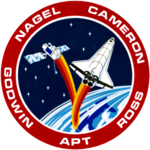STS-37
| Mission emblem | |||
|---|---|---|---|

|
|||
| Mission dates | |||
| Mission: | STS-37 | ||
| COSPAR-ID : | 1991-027A | ||
| Crew: | 5 | ||
| Begin: | April 5, 1991, 14:22:45 UTC | ||
| Starting place: | Kennedy Space Center , LC-39B | ||
| Landing: | April 11, 1991, 13:55:29 UTC | ||
| Landing place: | Edwards Air Force Base , Runway 33 | ||
| Flight duration: | 5d 23h 32m 44s | ||
| Earth orbits: | 93 | ||
| Rotation time : | 93.8 min | ||
| Orbit inclination : | 28.5 ° | ||
| Apogee : | 465 km | ||
| Perigee : | 449 km | ||
| Covered track: | 4.0 million km | ||
| Payload: | Compton Gamma Ray Observatory | ||
| Team photo | |||
 v. l. No. Kenneth Cameron, Jerome Apt, Steven Nagel, Jerry Ross, Linda Godwin |
|||
| ◄ Before / After ► | |||
|
|||
STS-37 ( english S pace T ransportation S ystem) is a mission designation for the US Space Shuttle Atlantis (OV-104) of NASA . The launch took place on April 5, 1991. It was the 39th space shuttle mission and the eighth flight of the space shuttle Atlantis. The main purpose of this mission was to deploy the Compton Gamma Ray Observatory (CGRO).
team
- Steven Nagel (3rd space flight), commander
- Kenneth Cameron (1st spaceflight), pilot
- Jerry Ross (3rd space flight), mission specialist
- Jerome Apt (1st spaceflight), mission specialist
- Linda Godwin (1st spaceflight), mission specialist
Mission overview
The launch was scheduled for April 5, 1991 at 14:18 UTC. It was delayed a few minutes by light cloud cover and took place at 14:22:45 UTC. The takeoff weight was 116,040 kg.
The main payload, the gamma-ray observatory CGRO, was launched on the third day of flight. It is the second of NASA's four major observatories. The Hubble Space Telescope , launched on the STS-31 mission in April 1990, was the first. CGRO was supposed to observe high-energy gamma-ray emissions in the sky for two years, which cannot penetrate the earth's atmosphere. At over 15 tons, it was the heaviest satellite launched by a space shuttle in low orbit. It was also the first satellite that could be refueled by a shuttle. After five months in space, the telescope previously known as the “Gamma Ray Observatory” was renamed “Compton Gamma Ray Observatory” in honor of Nobel Prize winner Arthur Holly Compton , who had done important work in the field of gamma radiation. The CGRO consisted of the Burst and Transient Source Experiment (BATSE), the Imaging Compton Telescope (COMPTEL), the Energetic Gamma Ray Experiment Telescope (EGRET) and the Oriented Scintillation Spectrometer Experiment (OSSE).
Despite repeated attempts, the antenna of the CGRO by the ground control of the Goddard Space Flight Center in Greenbelt ( Maryland to activate), success was missing. Therefore, the two astronauts Jerry Ross and Jay Apt, who were trained for this unscheduled action, performed a space exit (EVA) that was not on the flight plan. They were able to activate the antenna manually after just 17 minutes. It was the first unscheduled exit since the STS-51-D mission in April 1985.
The following day, April 8, Ross and Apt conducted a scheduled EVA, the first since STS-61-B in November 1985. Transportation methods for the crew and equipment were tested in order to be prepared for the maintenance of the planned Freedom station (Crew and Equipment Translation Aids, CETA for short). One of the experiments examined manual, mechanical, and electrical methods of moving material along the outside of long structures in space. Although all three methods worked, the astronauts reported that manual pushing would work best. Both EVAs together lasted ten hours 49 minutes.
The “Space Station Heat Pipe Advanced Radiator Experiment (SHARE II)” first formed bubbles in its plexiglass tubes, which had already been a problem with the first SHARE experiment during the STS-29 mission . However, this was subsequently prevented. SHARE II contained a new distribution system for heating the future space station. Also on board was the Bioserve Instrumentation Technology Associates Materials Dispersion Apparatus (BIMDA), which explored the commercial benefits of experiments in the fields of biomedicine, manufacturing processes, and fluid science. In addition, the “Protein Crystal Growth” experiment was carried out, which had already been in space eight times in a different form. Pilot Kenneth Cameron was the main user of the "Shuttle Amateur Radio Experiment ( SAREX )"; the other five crew members also took part as radio amateurs .
The landing took place on April 11, 1991 at 13:55 UTC on runway 33 at Edwards Air Force Base in California . The landing was planned a day earlier, but had been postponed by one day due to unfavorable weather. The landing weight was 86,227 kg. The orbiter returned to the Kennedy Space Center on April 18 .
See also
Web links
- NASA Mission overview (English)
- Video summary with comments of the crew (English)
- STS-37 in the Encyclopedia Astronautica (English)
